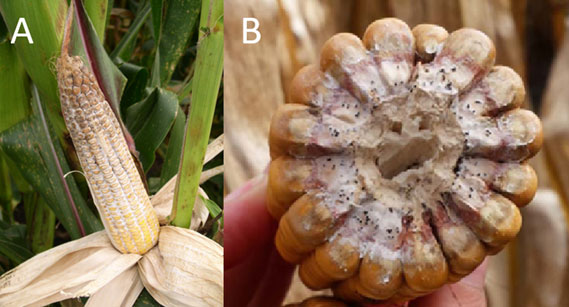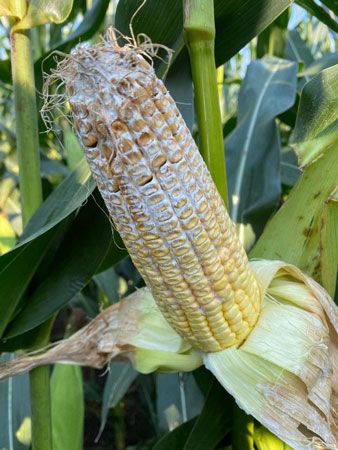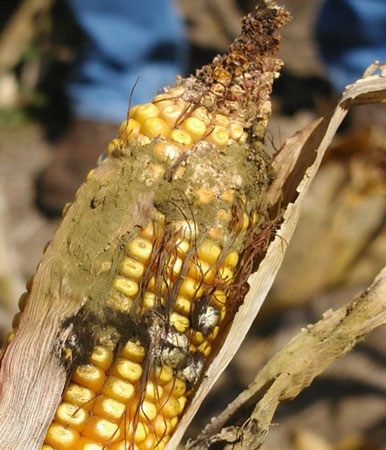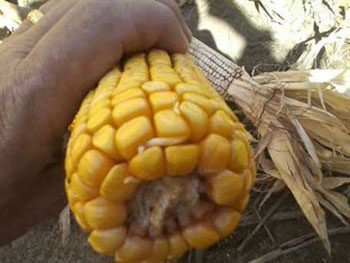As the growing season for corn is wrapping up in Kansas and many are in the midst of harvest, some are finding issues with impacted ear and grain quality. Late-season precipitation, as seen in many areas in 2025, can increase the risk of fungal growth on corn ears, promote pre-harvest sprouting, and decrease test weight. It is critical to properly identify ear rots in the field because many of the fungi responsible for ear rots produce toxic chemicals (known as mycotoxins), which can harm livestock and humans. Grain contaminated with mycotoxins can be difficult to market and may be docked in price. The most common ear rot diseases are Diplodia ear rot (Figure 1), Gibberella ear rot (Figure 2), and Aspergillus ear rot (Figure 3).

Figure 1. White mold on corn ear, indicative of Diplodia ear rot (Figure 1A, Courtesy of G. Munkvold), and black pycnidia produced by the fungus that causes Diplodia ear rot (Figure 1B, Courtesy of M. Romero).
Diplodia ear rot infection commonly occurs in the two weeks prior to and after silking (Figure 1A). The ear rot phase first becomes visible from a distance when husks turn tan prematurely. Black specks (fungal fruiting bodies known as pycnidia) appear on the husk, shank, and kernels (Figure 1B). When pulling the husks back, the ear will have a whitish mold forming in the grooves between kernel rows, usually starting at the base of the ear and progressing toward the tip. Over time, the white moldy appearance may turn brown. The ear rot phase results in moldy, low-test-weight kernels that frequently result in dockages at grain elevators. Unlike other ear rots, including Gibberella, Aspergillus, and Fusarium ear rots, Diplodia ear rot does not produce mycotoxins.

Figure 2. White/pinkish mold at ear tips is characteristic of Gibberella ear rot. Photo by Rodrigo Onofre, K-State Research and Extension.
Gibberella ear rot is caused by the fungus Gibberella zeae. It is a consistently important mycotoxigenic fungus in the northern Corn Belt, producing vomitoxin, zearalenone, and other toxins. Gibberella ear rot can be identified most readily by the distinctive red or pink color of the mold. It almost always begins at the tip of the ear. The prevalence of Gibberella ear rot tends to increase when cool, wet weather occurs during early silking. Extended periods of rain in the fall that delay harvest increase disease severity. Gibberella ear rot will be most severe in continuous corn fields or in areas where there is wheat affected by Fusarium head blight (scab), which is caused by the same pathogen.
Aspergillus ear mold is favored by hot and dry conditions. Aspergillus can produce aflatoxin, a well-known carcinogen that is highly regulated by the Food and Drug Administration (FDA). On the ear, colonies of Aspergillus flavus are a greenish-yellow, dime- to quarter-sized mold that grows between the kernels. In severe cases, the mold may cover a significantly larger portion of the ear (Figure 3). Often, there is little correlation between the percentage of moldy ears in a field and the actual level of aflatoxin. Corn that dries down rapidly may accumulate less toxin, and some field strains are poor producers of aflatoxin. On the other hand, strains that produce copious amounts of aflatoxin may need to be present on a relatively low percentage of ears to cause problems at the elevator. For more information on aflatoxin in corn, please read the accompanying eUpdate article in this issue.

Figure 3: Greenish mold is characteristic of Aspergillus ear mold. Photo by Doug Jardine, K-State Research and Extension.
Low test weight
The occurrence of moldy ears can affect test weight in corn, resulting in light-weight and chaffy grain. Other causes of low test weight are: 1) higher grain moisture, 2) abiotic stress conditions (e.g., drought and heat), 3) late-season leaf diseases, and 4) below-normal temperatures during the end of grain fill.
Moldy ears can also impact final grain quality through the production of mycotoxins [aflatoxins, deoxynivalenol (DON), fumonisins, and ochratoxin], potentially affecting the quality of the grain as an animal feeding source. It can also cause issues for storage and end-use processing (e.g., starch quality and ethanol).
Sprouting
Pre-harvest sprouting is likely to occur when dry grain (less than 20% moisture) is re-wetted. This situation is particularly associated with late-season rains, warm temperatures, and upright ears. The main result is a sprouted kernel in the lower section of the corn ear (Figure 4). If this is a widespread issue throughout the field, grain quality can be compromised, leading to problems in storage.

Figure 4. Premature corn kernel sprouting in the lower section of the ear. Photo by Eric Adee, K-State Research and Extension.
Time home points
These production issues are occurring now in some fields in Kansas. One of the most effective management practices is to scout fields for these issues and estimate the portion of your field affected by moldy ears or pre-harvest sprouting problems. Timely harvest and pre-screening of corn ears can help mitigate these issues and diminish the economic impact.
For more information on corn ear abnormalities, please refer to K-State Research and Extension publication EP169 “Abnormal Corn Ears” at https://bookstore.ksre.ksu.edu/item/abnormal-corn-ears_EP169.
Rodrigo Onofre, Extension Row Crop Pathology Specialist
onofre@ksu.edu
Logan Simon, Southwest Area Agronomist
lsimon@ksu.edu